Yellowtail Snapper
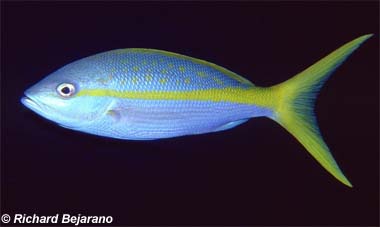
Lutjanus chrysurus
This common snapper prefers schooling in small groups in and around reefs in the Western Atlantic. It has a distinct yellow lateral line that starts off narrow near the eye and widens as it reaches the forked, yellow caudal fin. It has blue-ish or olive sides with yellow spots above the line, and pale white below. These snappers grow to about 30 inches and are a popular food fish, as well as an attraction to divers and in public aquariums.
Order: Perciformes
Family: Lutjanidae
Genus: Lutjanus
Species: chrysurus
Common Names
English language common names include cola, yellowtail snapper and yellowtail. Other common names are chryzor (Polish), cioba (Portuguese), colas (French), colirrubia (Spanish), geelstaart (Dutch), grastelchi’i pieda (Papiamento), gristelchi (Papiamento), luciano-cauda-amarela (Portuguese), mulata (Portuguese), rabirrubia (Spanish), rabittabia (Spanish), rubia (Spanish), sad kola (Creole), sarde queue jaune (French), vivaneau queue jaune (French).
Importance to Humans
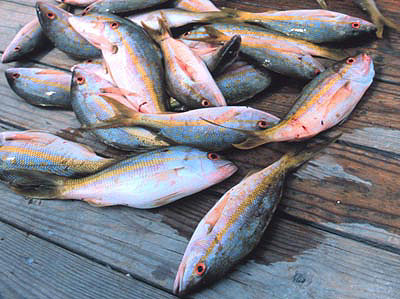
The yellowtail snapper is a sport fish, caught mainly on light tackle. It also appears in commercial catches made using seines and trawls. Its edibility is fair to good and is marketed fresh in the Bahamas.
This snapper is a popular game and food fish, composing a major portion of both the sport and commercial catches of Florida’s snapper fishery. Shrimp trawlers account for a large portion of the total fishing mortality on this snapper, as juveniles occur over soft bottom areas containing high shrimp populations. This species is also the focus of a number of commercial aquaculture operations. It is marketed as both fresh and frozen for human consumption.
Danger to Humans
There have been reports of ciguatera poisoning from human consumption of yellowtail snappers although such instances are considered rare for this species. Ciguatera poisoning is caused by dinoflagellates (microalgae) found on dead corals or macroalgae. By feeding on these corals and macroalgae, herbivorous fishes accumulate a toxin generated by these dinoflagellates. Largely a phenomenon of tropical marine environments, ciguitoxin accumulates still further in snappers and other large predatory reef species that feed on these herbivorous fishes. If accumulated levels of the toxin are great enough they can cause poisoning in humans whom consume the flesh of these fishes. Poisoned people report having gastrointestinal problems for up to several days, and a general weakness in their arms and legs. It is very rare to be afflicted with ciguatera poisoning.
Conservation
The yellowtail snapper is not listed as endangered or vulnerable with the World Conservation Union (IUCN). The IUCN is a global union of states, governmental agencies, and non-governmental organizations in a partnership that assesses the conservation status of species.
> Check the status of the yellowtail snapper at the IUCN website.
Geographical Distribution

The yellowtail snapper is found in the western Atlantic Ocean from Massachusetts to Bermuda and southward to southeastern Brazil, including the Gulf of Mexico and Caribbean Sea. It is most common in the Bahamas, off south Florida and in the Caribbean Sea.
Habitat
Adult yellowtail snappers live over sandy areas near deep reefs at depths of 32-230 feet (10-70m), while small adults tend to congregate over hard bottom habitats. Once established, adult yellowtail snapper tend to remain in the same area for long periods of time. This snapper is usually seen well above the substrate, swimming about in small groups. Juveniles reside inshore in seagrass bed nursery areas that offer protection from predation while they mature.
Biology
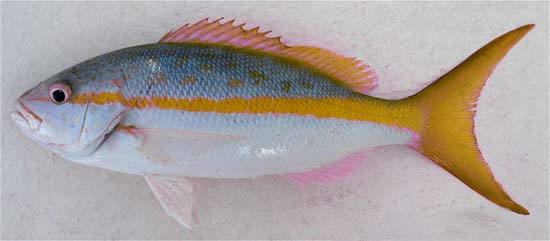
Distinctive Features
In comparison with most other snapper species the head and mouth of the yellowtail snapper are small. The pectoral fins are long, reaching the anus. An unusual characteristic among snappers in our area, the caudal fin of this species is deeply forked with the upper lobe longer than the lower one.
Coloration
The yellowtail snapper has an olive to bluish back and upper sides with yellow spots. The lower sides and belly have alternating narrow, longitudinal pink and yellow stripes. Perhaps most conspicuously, a prominent midlateral yellow stripe begins at the mouth and continues to the caudal fin base, becoming broader as it passes the dorsal fins. The caudal fin is yellow while the anal and pelvic fins are whitish in color. Unlike a number of other snapper species, the yellowtail snapper never possesses a dark lateral spot.
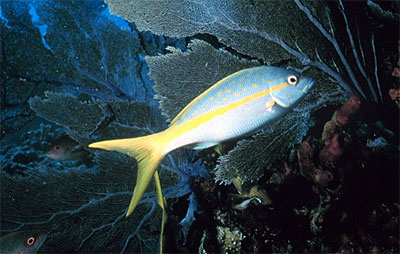
Dentition
Although most teeth in the upper jaw are densely packed, fine, or hair like “villiform” teeth, there are several canine teeth present as well – the latter constituting a definitive characteristic of all snappers. The lower jaw, which projects slightly beyond the upper, has larger villiform teeth.
Size and Age
Adult yellowtail snappers may reach a maximum length of 30 inches (75cm). This fish rarely exceeds weights of 5 pounds. Sexual maturity is attained at lengths of 10-12 inches (25-30cm) and life expectancy is 6-14 years.
Food Habits
Adult yellowtail snappers are nocturnal predators. They feed on benthic organisms including crabs, shrimp, cephalopods, worms, and fish. Juveniles, living primarily among seagrasses, feed on plankton.
Reproduction
Spawning occurs year round, peaking at different times in different locations, with an overall activity decline in the winter months. Spawning yellowtail snapper form offshore aggregations. The spherical eggs are released into open waters and contain an oil droplet, which provides buoyancy in their pelagic environment. The eggs hatch within 24 hours, producing sparsely pigmented larvae. Although little is known about lutjanid larvae, they are planktonic at lengths less than 10mm. They eventually settle out of the plankton, onto suitable substrate that offers some protection from predators.
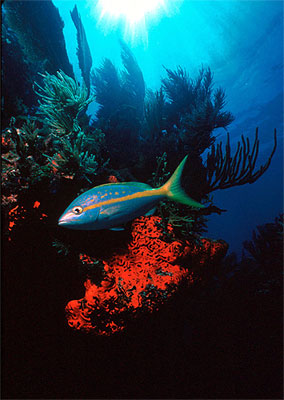
Predators
Natural predators of adult yellowtail snapper include sharks and other large predatory fishes, including barracuda, mackerel and grouper in addition to other snapper species. Larvae and juveniles face a wide array of predators.
Taxonomy
The German physician and ichthyologist, Marcus Elieser Bloch whom is often noted today for his detailed and much valued scientific engravings of fishes, described this snapper as Sparus chrysurus in 1791. Synonyms include Anthias rabirubia Bloch and Schneider 1801, Sparus semiluna Lacepede 1802, Mesoprion aurovittatus Agassiz 1829, Ocyurus rijgersmoei Cope 1871, and Lutjanus melanurus Jordan and Gilbert 1883. The currently accepted taxonomy for this species is Lutjanus chrysurus. The species name is derived from the Greek “chryso” which is translated as golden.
Prepared by: Cathleen Bester